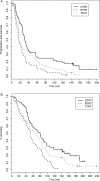Six-month progression-free survival as an alternative primary efficacy endpoint to overall survival in newly diagnosed glioblastoma patients receiving temozolomide
- PMID: 20167815
- PMCID: PMC2940590
- DOI: 10.1093/neuonc/nop034
Six-month progression-free survival as an alternative primary efficacy endpoint to overall survival in newly diagnosed glioblastoma patients receiving temozolomide
Abstract
We assessed six-month progression-free survival (PFS) as an alternative primary efficacy endpoint to overall survival in newly diagnosed glioblastoma multiforme (GBM) patients receiving temozolomide (TMZ). A total of 183 patients with newly diagnosed GBM enrolled in 3 phase II protocols at the University of California-San Francisco were included. Patients were treated with interventions based on the Stupp regimen, each with the added component of a second oral agent given concurrently with radiotherapy and TMZ, followed by its coadministration with adjuvant TMZ. We examined whether progression status at 2, 4, and 6 months predicted subsequent survival using the landmark analysis. The hazard ratios of death as a function of progression status were estimated based on the Cox proportional hazards model after adjustment for putative prognostic factors. Progression status at 2, 4, and 6 months were all consistently found to be strong predictors of subsequent survival in all studies. The study-specific hazard ratios associated with progression status at 6 months ranged from 2.03 to 3.39. The hazard ratios associated with the earlier time points (2- and 4-month progression) all exceeded 2 in magnitude, ranging from 2.29 to 4.73. P-values were statistically significant for all time points. In this report, we demonstrated a strong association between the endpoints of PFS at 2, 4, and 6 months and survival. Patients who showed the signs of early progression were at significantly higher risk of earlier death. Our analysis suggests that 6-month PFS may be an appropriate primary endpoint in the context of phase II upfront GBM trials in the TMZ era.
Figures


Similar articles
-
Long-term therapy with temozolomide is a feasible option for newly diagnosed glioblastoma: a single-institution experience with as many as 101 temozolomide cycles.Neurosurg Focus. 2014 Dec;37(6):E4. doi: 10.3171/2014.9.FOCUS14502. Neurosurg Focus. 2014. PMID: 25434389
-
Dexamethasone administration during definitive radiation and temozolomide renders a poor prognosis in a retrospective analysis of newly diagnosed glioblastoma patients.Radiat Oncol. 2015 Oct 31;10:222. doi: 10.1186/s13014-015-0527-0. Radiat Oncol. 2015. PMID: 26520780 Free PMC article.
-
Extended adjuvant temozolomide for treatment of newly diagnosed glioblastoma multiforme.J Neurooncol. 2012 May;108(1):173-7. doi: 10.1007/s11060-012-0826-3. Epub 2012 Mar 2. J Neurooncol. 2012. PMID: 22382781
-
Updated systematic review and meta-analysis of extended adjuvant temozolomide in patients with newly diagnosed glioblastoma.Neurooncol Adv. 2023 Jul 13;5(1):vdad086. doi: 10.1093/noajnl/vdad086. eCollection 2023 Jan-Dec. Neurooncol Adv. 2023. PMID: 37638346 Free PMC article. Review.
-
Combining apatinib and temozolomide for brainstem glioblastoma: a case report and review of literature.Ann Palliat Med. 2022 Jan;11(1):394-400. doi: 10.21037/apm-22-22. Ann Palliat Med. 2022. PMID: 35144430 Review.
Cited by
-
Measuring clinical benefit: use of patient-reported outcomes (PRO) in primary brain tumor clinical trials.Curr Oncol Rep. 2013 Feb;15(1):27-32. doi: 10.1007/s11912-012-0276-2. Curr Oncol Rep. 2013. PMID: 23054936
-
Progression-free survival versus post-progression survival and overall survival in WHO grade 2 gliomas.Acta Oncol. 2024 Oct 20;63:798-804. doi: 10.2340/1651-226X.2024.40845. Acta Oncol. 2024. PMID: 39428639 Free PMC article.
-
Challenges and opportunities of predicting overall survival benefit from improvements to recurrence-free survival in stage II/III melanoma: a correlation meta-analysis.Immunooncol Technol. 2025 Feb 3;25:101042. doi: 10.1016/j.iotech.2025.101042. eCollection 2025 Mar. Immunooncol Technol. 2025. PMID: 40093596 Free PMC article.
-
Analysis of heterogeneity in T2-weighted MR images can differentiate pseudoprogression from progression in glioblastoma.PLoS One. 2017 May 17;12(5):e0176528. doi: 10.1371/journal.pone.0176528. eCollection 2017. PLoS One. 2017. PMID: 28520730 Free PMC article.
-
Evaluation of RANO response criteria compared to clinician evaluation in WHO grade III anaplastic astrocytoma: implications for clinical trial reporting and patterns of failure.J Neurooncol. 2015 Mar;122(1):197-203. doi: 10.1007/s11060-014-1703-z. Epub 2015 Jan 11. J Neurooncol. 2015. PMID: 25577400 Free PMC article.
References
-
- Stupp R, Mason WP, van den Bent MJ, et al. Radiotherapy plus concomitant and adjuvant temozolomide for glioblastoma. N Eng J Med. 2005;352:987–996. - PubMed
-
- Chang SM, Lamborn KR, Malec M, et al. Phase II study of temozolomide and thalidomide with radiation therapy for newly diagnosed glioblastoma multiforme. Int J Radiat Oncol Biol Phys. 2004;60:353–357. - PubMed
-
- Butowski N, Prados MD, Lamborn KR, et al. A phase II study of concurrent temozolomide and cis-retinoic acid with radiation for adult patients with newly diagnosed supratentorial glioblastoma. Int J Radiat Oncol Biol Phys. 2005;61:1454–1459. - PubMed
-
- Macdonald DR, Cascino TL, Schold SC, et al. Response criteria for phase II studies of supratentorial malignant glioma. J Clin Oncol. 1990;8:1277–1280. - PubMed
Publication types
MeSH terms
Substances
Grants and funding
LinkOut - more resources
Full Text Sources
Medical

